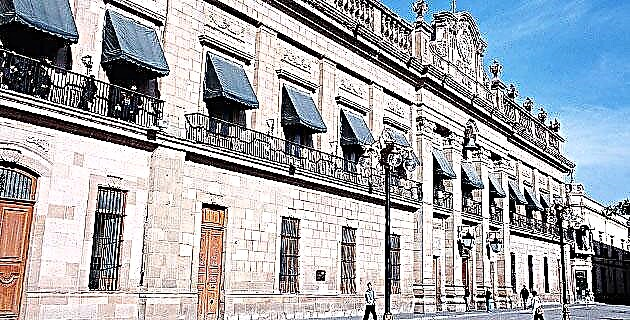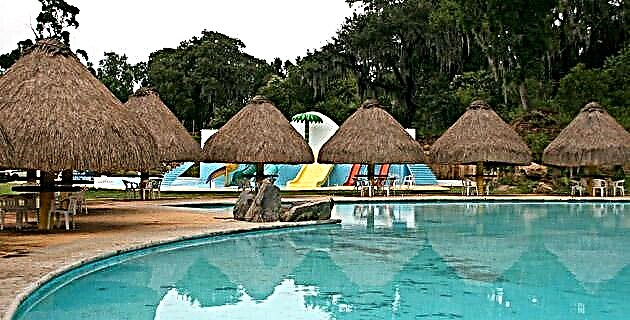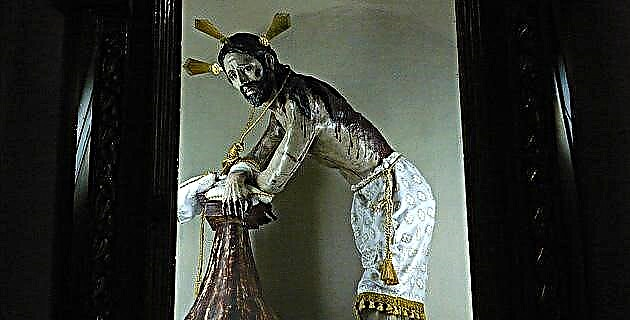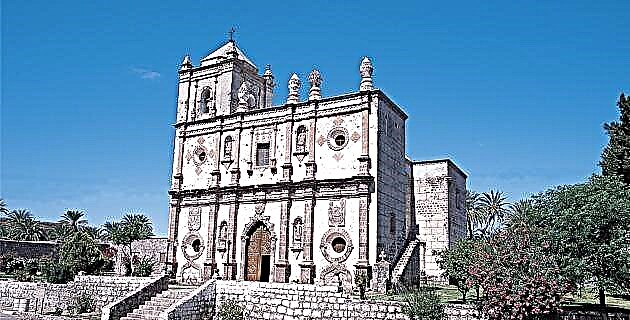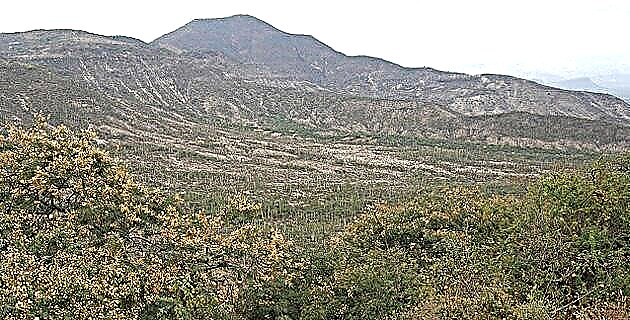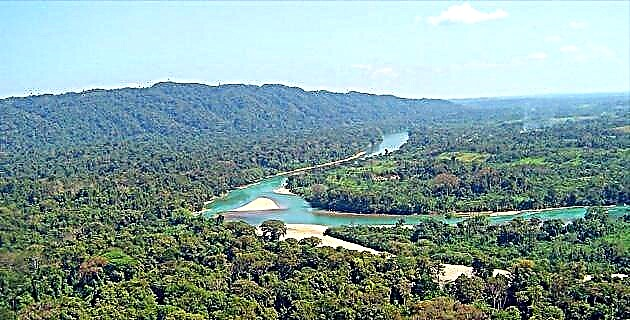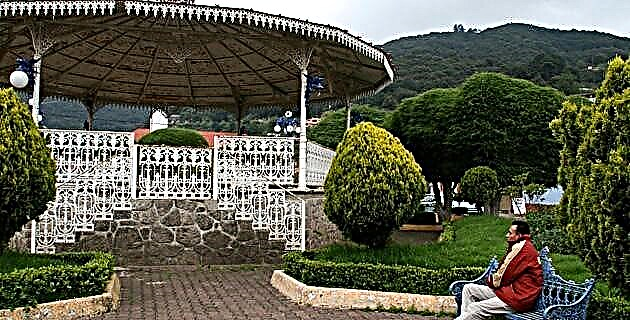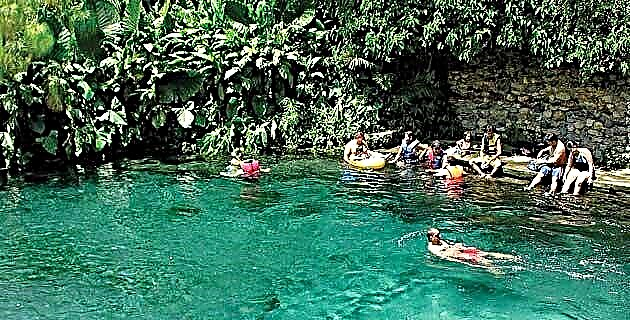
Las Estacas is constituted by an exuberant environment surrounded by vegetation and crystalline waters where it is possible to swim and practice other water activities. A paradise in the heart of Morelos.
Escorted during our journey through a semi-arid landscape of lowland jungle, we were surprised to find ourselves suddenly in front of a tropical paradise: a kind of island of exuberant vegetation in which the tall plumes of royal palms stood out. It was the Las Estacas Aquatic Natural Park, the green heart of Morelos.
After crossing a huge esplanade we entered the park, and the first thing we saw on our left, as a welcome, was an area of small lakes covered largely by lotus flowers and, towards the back, a palapa with an upholstered front by a beautiful vine of yellow bells that, in the high morning, opened generously in the sun. Further on, turning right, we come across a suspension bridge and there we were greeted by the soul of the park: the Las Estacas River, which runs through it for more than a winding kilometer. The tributary appeared to us like a ribbon, through whose transparency of silver reflections the emerald green of the aquatic vegetation appeared, which, at that point, looked like the hair of a mermaid crossing Las Estacas against the current. The landscape was so beautiful that we walked it slowly.
"Located in the municipality of Tlaltizapán, Las Estacas belonged to the old Temilpa ranch, and was opened to tourism in 1941 by Mr. Julio Calderón Fuentes as a spa and country ranch," says Margarita González Saravia, public relations manager of Las Stakes.
Accompanied by the biologist Hortensia Colín, responsible for the park's flora and fauna conservation project, we headed to where the river begins its constant flow of 7 thousand liters of water per second: a large spring whose spherical luminosity, in the bed itself , looks like a wavy mirror. There we boarded a raft that took us downstream. We went through a high tunnel of woven branches from which some bats emerged as frightened, no less than us, and defying the light of day. Then the current led us to a wooded backwater where the river gives the impression of stopping to enjoy, he too, the beauty of the environment, which borders on the cinematographic. The dense vegetation nuances the solar rays and causes a great wealth of chiaroscuro; the magic of the place stops us. “This place - Hortensia tells us - is known by the name of Rincón Brujo, and it has served as the setting for Mexican films such as El rincón de las virgenes, with Alfonso Arau, and American films such as Wild Wind, with Anthony Queen and Gregory Peck. Long before this place was used by Emiliano Zapata to rest and give his thirsty horse a drink ”.
We are struck by a lush and ancient amate that grows on the inner shore of Rincón Brujo; Its powerful and emerging roots have formed a kind of bridge between the two banks of the river that, at this point, narrows until it becomes a stream. Before our observation, the biologist Colín adds that the roots have dug numerous caverns, allowing the river to slide to reach the extensive space of the sections called Poza Chica and La Isla. From here the river continues its zigzagging course, in which it is It is possible to observe turtles and fish of different sizes. The spectacle of the crystalline waters can be enjoyed by letting yourself be carried away by the current, or by walking along its shores escorted by the numerous royal palms that, despite their Caribbean origin, coexist in perfect harmony with the ancient amates and other native trees of the region. Later, after passing La Isla and Poza Chica, we decided to continue our walking tour and savor, in a rustic but comfortable restaurant-bar, an excellent piña colada accompanied by a very well served burger on the grill.
On the way to the bungalow area, Hortensia shows us an old amate and tells us that it was painted by Diego Rivera for the mural in the National Palace in Mexico City. We admire its majesty, but we notice that there are parts of the tree that are repaired with a material the color of cement, and our knowledgeable guide, the teacher Colín, explains that this amate, like many others, had been attacked by a plague that put in danger its existence. What we were seeing was the treatment with which they had managed to save these trees, monuments not only of nature but also of the culture of Mexico.
THERE ARE LOVES THAT KILL…
In the area of the cozy and comfortable vests, we see how another lover has managed to embrace with its distended trunk and its roots that sprout to the surface a flimsy sapote that grows near him. Once again our guide illustrates this for us. This type of amate is popularly known as “matapalo”: it surrounds the nearest tree and, what at first seems like a loving embrace, or at least a protective one, becomes for the chosen one a certain death by suffocation.
On our way we pass through the pool area, the picnic area and the fish pond –where you can practice controlled fishing–, until we reach Fort Bambú. This is one of the four accommodation options offered by Las Estacas. In our opinion, in addition to being economical, this unique ecological hostel offers its guests a very quiet environment because it is at the end of the park.
On our way back, we cross the little bridge that goes over the pond and connects Fort Bambú with the rest of Las Estacas. Then we make a detour to the extreme right of the park to visit the area of the palm and adobe huts, the most ecological accommodation in Las Estacas: its rusticity causes an even greater distance from the “civilized” world from which we come.
In Las Estacas, a natural reserve in the state of Morelos since 1998, with an area of 24 hectares, an ecological restoration project is being carried out by its owners, the Saravia family, and the Biological Research Center of the Universidad del State of Morelos, which has involved neighboring communities. Such interaction has made it possible to reforest the nearby Los Manantiales hill with some eight thousand plants of ten species, which has saved several of them from extinction, some outstanding for their healing properties. An example of these is the bone stick (Euphorbia fulva), whose presence in Morelos is reduced to twenty trees that are exploited only as seed suppliers once a year. Although the name “bone glue” proclaims its main property, we want to know more about it, so the biologist Colín comments that bone glue produces a latex that is used to immobilize broken bone and to relieve rheumatic pain and sprains. However, the lack of information and the unconsciousness of many almost managed to extinguish it, at least in the state of Morelos. But as our curiosity about the bone stick did not diminish, we decided to go with the teacher Colín to the Las Estacas nursery, where we could admire, among others, the amate seedlings, and meet the famous bone stick, one of the wonders of Mexican nature.
All this shows that Las Estacas is, without a doubt, something more than a place of rest and recreation; It also symbolizes the product of a work in favor of the environment and man.
HOW TO GET
Leaving the highway to Cuernavaca we follow the Mexico-Acapulco highway. We must go on the right lane to take the deviation towards Paseo Cuauhnáhuac-Civac-Cuautla. We continue along this road, which later becomes a road. Almost immediately a poster appears announcing the place called Cañón del Lobo that passes between two hills; We cross it and 5 minutes later we turn right at the deviation that says Tlaltizapán-Jojutla, and after about 10 minutes, on the left, we will find the Las Estacas Aquatic Natural Park.


